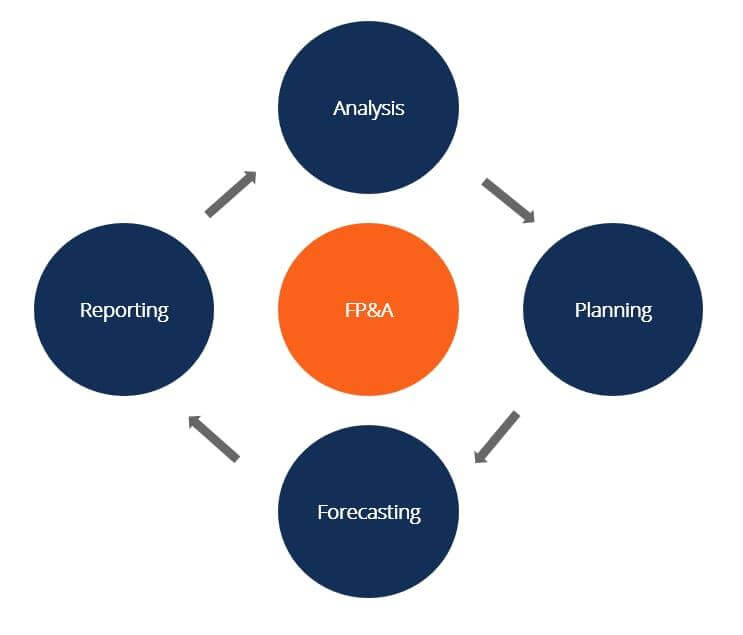Gartner defines Enterprise Performance Management (EPM) as the process that seeks to improve business performance by monitoring performances across the organization, in different departments. The EPM system works by first integrating data from different source applications that are used in various lines of businesses and then creating a commonly agreed set of performance measures across different departments in the company.
The objective of the EPM is to set the right performance standards and set goals to fulfil organizational objectives to make effective communications and set the right expectations for managers and employees. This will help determine the plan on how to achieve these performance standards, as well as to assess reasons for shortfalls, if any, to make improved business decisions.
The Traditional Approach To EPM
Historically, organizations would create financial budgets using different forecast methods, and compare actual performance at the end of a year with the forecasted financial numbers to evaluate business performance. Thus, Financial Planning & Analysis, using spreadsheets, became an essential and extended process to evaluate accounting and company financial information to arrive at important information such as financial ratios and statements. These metrics help determine the answers to business performance measurements.
Challenges With Traditional Spreadsheet-Based FP&A Process
FP&A refers to a set of processes that help identify future revenue and expenditure trends that will have an immediate or long-term impact on strategic goals and business performance.
FP&A Process teams play a very crucial role in organizations as they are responsible for the processes of budgeting, forecasting, managing the cash flow of the company. They utilize quantitative and qualitative analysis techniques to assess how well the company is moving towards achieving its future objectives and goals.
The FP&A department is also responsible for recommending and suggesting to the upper management how to improve financial health and drive business growth.

Historically, the FP&A was mainly done to assess the future and growth trajectory of the company. It is done by compiling the financial data across different lines of businesses and business units and then consolidating the same for creating financial reports and coming up with enterprise performance management measures, followed by calculating the financial metrics for measuring the business performance.
The traditional spreadsheet-based FP&A creates several challenges for businesses, such as,
- Difficult to scale as the volume of business grows
- Difficult to monitor and understand the financial health of the business
- Difficult to understand what is going on with every customer
- Rigid forecasting processes that are difficult to align with the changing business conditions
Modern Approach
However, as businesses and markets have become more complex today, companies have realized that FP&A principles need to be extended across the different departments in order to come up with a more holistic picture of business health.
The present-day business scenarios, with its quickly evolving nature, call for an agile system that provides decision-makers with a common framework for measurement and collaboration and which allows for a cross-functional understanding of the effect of each area’s performance with well-defined, published and measurable performance objectives and metrics. This creates the need for xP&A
Learn how Cashflow Management Solution enables agile & resilient business planning by channelling all your data, lying across departments.
What Is XP&A?
xP&A refers to the modern enterprise performance management strategy where traditional silos in planning and performance management processes that exist between the financial and different operations are broken down to deliver transformative business outcomes. X refers to continuous planning that extends into every business department - finance, sales, HR, marketing, supply chain, and IT
Today, as agility has become important in business planning, xP&A has become an important means to drive improved business value.
Gartner projects that, By 2024, 70 percent of new FP&A projects will become extended planning and analysis (xP&A) projects, thereby extending their scope beyond the finance domain into other areas of enterprise planning and analysis.
The pandemic has only further highlighted the need for businesses to incorporate agility into their enterprise performance management and business plans, by incorporating real-time feedback from all areas of their businesses. As supply chains have been disrupted, the workforce has migrated to the work-from-home paradigm and consumer preferences and habits have changed overnight, business parameters have changed on very short notice. This requires business decision-makers to integrate information on very short notice from across the organization and consolidate that to make effective and agile decisions based on real-time feedback.
With xP&A, the business would consider and integrate information from all areas of the business to forecast and evaluate, rather than looking at the situation and concerns from only a financial perspective.
Conversely, by integrating information from every aspect of the business into an xP&A, the office of the CFO becomes the driver of strategic decisions. Therefore, the need for the future is to incorporate agility into the plan and utilize the xP&A methodology with the use of appropriate technology platforms to drive improved and more effective decisions.
For example, the sales team will have numbers related to sales forecasts, territories that they are planning to expand into and incentive amounts that they are planning to roll out. The marketing team will have plans for new campaigns which will also depend upon the inputs from the sales team. The HR team will create plans related to hiring, compensation, and addressing the training requirements.
Finally, the FP&A team will be responsible for creating revenue plans and making decisions related to managing the cash flow and working capital. Under the traditional enterprise performance management with FP&A exercise, the finance team will be making the plans and FP&A in isolation, without integrating information from other areas of the business. The xP&A will require businesses to integrate information from all the different departments to make scenario-based plans, and what-if analysis to predict the best course of action. This is known as Integrated Business Planning.
How Should Organizations Prepare To Transition FP&A To XP&A?
The role of the CFO has transformed in recent times, and in nearly one-third of organisations, they are responsible for driving digital transformation in areas like cloud computing, data visualization and data science.
The turbulent business climate of today calls for greater agility in financial decision-making by incorporating the latest internal and external data. It also calls for greater collaboration between finance and the rest of the departments within the organisation.
2. Automate the process to ensure that more time is spent on data analysis, than on compiling data
3. Modernize the processes to move away from decentralized reporting to 360-degree business intelligence at the click of a button
4. Set up data quality processes to ensure that the analysis is error-free
Benefits Of An Automated XP&A System
1) Collaboration is encouraged with a transparent and real-time view into key business metrics - financial and operational
2) Scenario-based planning makes it easier to spot growth opportunities for the business that may not be apparent to the management
3) Complete alignment of stakeholders across different departments on a set of commonly agreed measurements and objectives
4) Empowers the FP&A department to drive business transformation and improvements by making key strategic decisions backed by a holistic view of the business, cutting across departmental silos.
To reap the benefits of modern enterprise performance management with xP&A, organizations need a unified platform that can integrate planning across the different function areas, thus enabling a "connected" planning paradigm.
What is Anaplan and what does it do?
Anaplan is a cloud-based connected financial and business planning platform that allows you to deploy enterprise performance solutions across your entire organisation and reach to every department. With real-time calculations, Anaplan allows you to see changes immediately as you do what-if analysis and scenario-based modelling. Thus, it enables you to minimize mechanical planning and maximise business analysis and insight.
Among the useful features of the Anaplan platform is that it allows business users to quickly and easily interact with the system to enter data in a variety of ways to develop operational plans and budgets at any level within the organization. Anaplan is a highly configurable and flexible platform that allows organizations to choose a number of methods to interact with the data, helping keep a bird’s eye view across departments as well as to strategize and collaborate with agility.

With Anaplan, for example, sales leaders can quickly set new targets and push them out to different business units. By linking revenue targets to sales capacity, Anaplan enables strategic and connected planning. By utilizing multi-dimensional modelling and in-memory technology, Anaplan delivers results in real-time.
At Polestar Solutions, we are Anaplan Solution Partners with a team of highly experienced Industry Veterans, Architects and motivated individuals with a knack to deliver top-notch strategy & services for your Organisation. We have developed industry-leading solutions for multiple Fortune 500 Clients. Our growth is a testimony of our good work and it has transitioned us into ranking 1st in 2017 and for 3 consecutive years on Deloitte's Tech Fast 50 List, recently we featured on the Financial Times - High Growth Companies - Asia Pacific 2020.

The 𝗖𝗢𝗩𝗜𝗗-𝟭𝟵 pandemic has made it clear that enterprises need to build resilience into their operations, and have the ability to adapt and pivot quickly to thrive in new business conditions. One of the most critical factors that will help an enterprise success is to keep revising its plans and monitoring its enterprise performance management as per the evolving market conditions.



